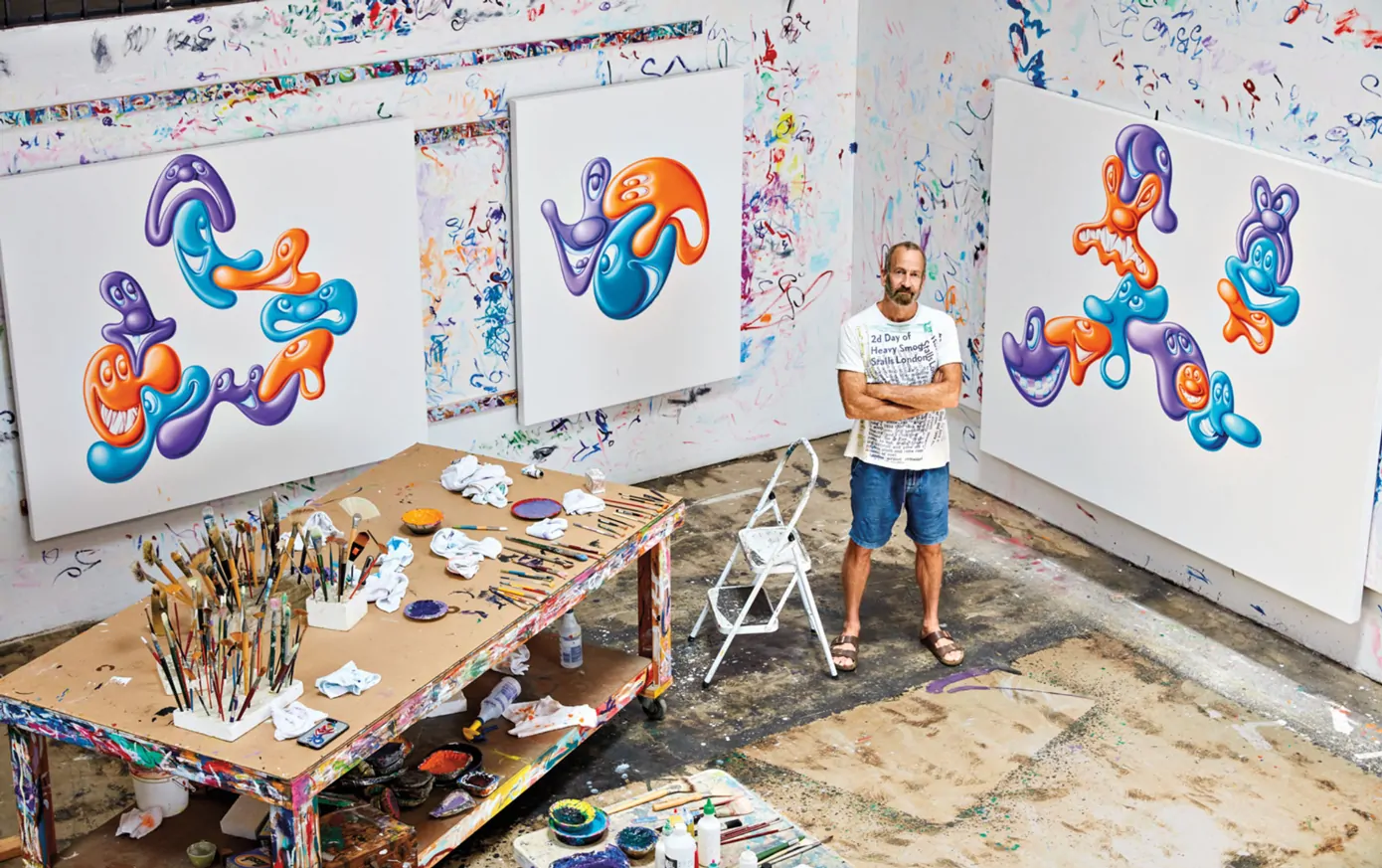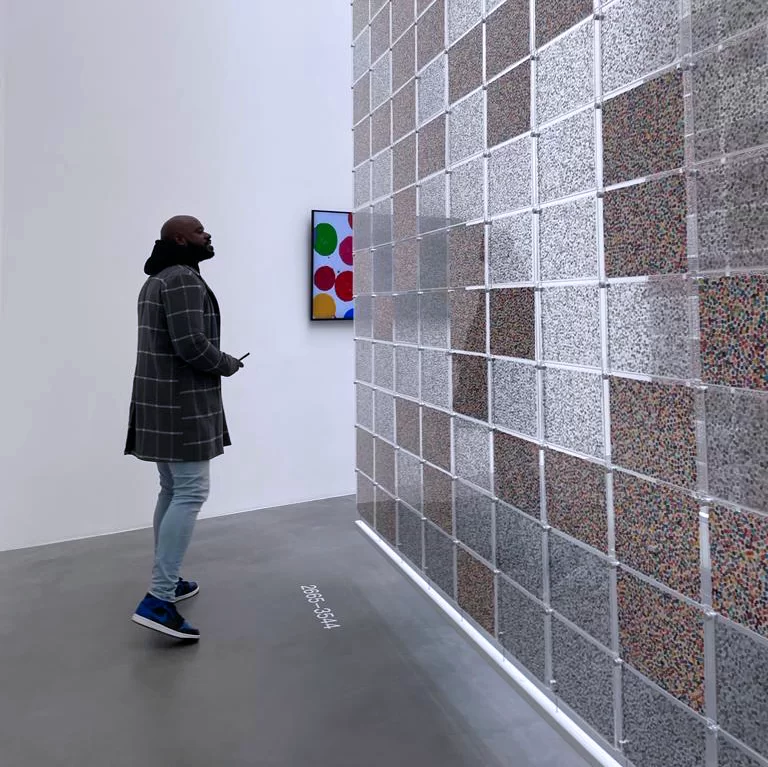Exploring the Playful, Emotional World of Kenny Scharf: How His Pop Surrealism Challenges Modern Life
The work of renowned artist Kenny Scharf takes us on a vibrant ride through a universe of imagination, where fantasy and reality collide, and every stroke pulses with joy, critique, and rebellion. Raised in 1960s Los Angeles — a city brimming with optimism, neon lights, car culture, and the early days of space exploration — Scharf absorbed the saturated, fantastical visuals of his surroundings, which became second nature.
These early experiences, from TV commercials to architectural design, helped shape the rich visual language he would go on to create — one that echoes with the colours of his childhood and the boundless energy of his future vision.
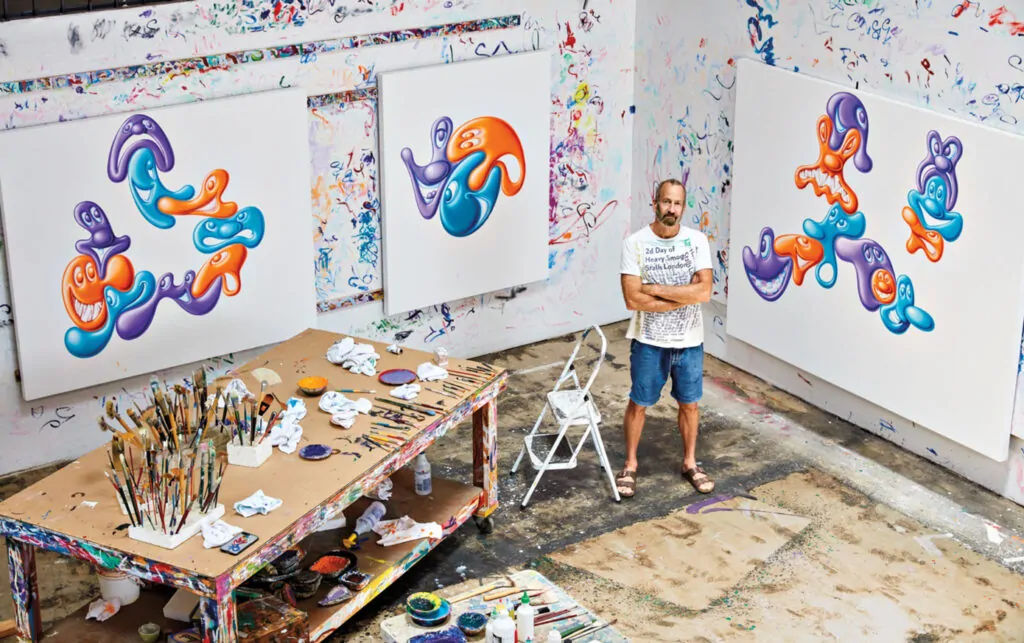
I am merely expressing the human condition where everything exists together at the same time and we each choose what to see and how to react.
Kenny Scharf
When Scharf moved to New York in the late 1970s, the East Village was already buzzing with energy, home to the punk ethos and the gritty, DIY spirit that defined the era. Here, alongside Keith Haring and Jean-Michel Basquiat, Scharf found kindred spirits who helped shape a cultural revolution. The area’s raw, rebellious vibe didn’t dictate Scharf’s vision; his direction was already set. But it did provide him with the freedom to dive deeper into his Pop Surrealist style — a blend of playful, exaggerated images with sharp social commentary.
Scharf’s works — often brimming with neon blobs, doughnuts, and faces full of exaggerated emotion — capture both a joyful nostalgia and a critical examination of the pressing issues surrounding consumerism and technology in today’s world. For Scharf, creating art isn’t about preaching a single message; it’s about offering layers of interpretation. His playful imagery invites all to engage, leaving it up to us to choose — the joy or the critique.
Long before emojis became shorthand for expression, Scharf communicated emotion with bold simplicity. Growing up in the explosion of colour TV, he recognised the potential of simplifying complex emotions into distinct, universal visuals. His fascination with cartoons and their ability to convey emotion laid the foundation for his unique aesthetic language, one that resonates in a world dominated by digital screens and graphic icons.
In his latest exhibition, Emotional, at MAM Shanghai, Scharf dives deep into the full spectrum of human emotions. This show marks an evolution in his ongoing exploration of feeling, capturing everything from anger to awe, and inviting viewers to connect with the visceral experience of emotion — in a way that feels both personal yet universal.
Scharf’s Cosmic Caverns — glowing installations that dissolve the boundaries between art, experience, and party — are a testament to his dedication to creating immersive environments. The Beach Club installation, with its lush plants, glowing colours, and surreal atmosphere, invites visitors to step into his California dreamscape, offering an escape from the everyday.
As Scharf looks back on his decades in the art world, one thing is clear: he’s never been afraid to push the boundaries of artistic expression. Whether he’s questioning the divide between high and low culture or creating spaces that invite the audience to step inside, Scharf’s work continues to evolve, maintaining the same relevance and freshness as it did when he first burst onto the scene.
Through it all, Scharf has remained true to his vision — to make people feel something real, something authentic. For him, it’s never just about looking; it’s about engaging, questioning, and fully experiencing everything in between.
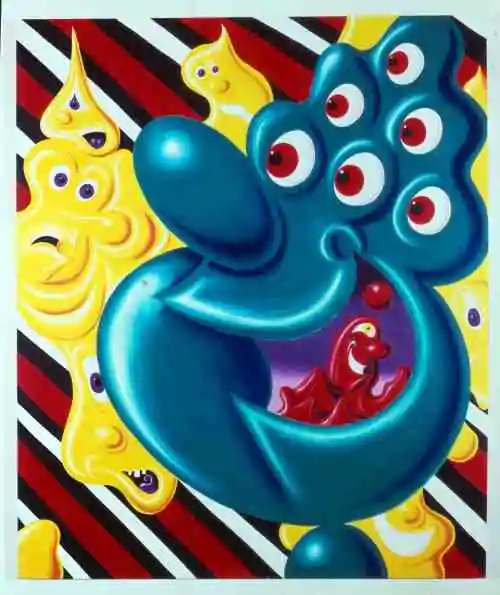
Oil on Canvas
77 x 65 Inches
1984
© Kenny Scharf
You grew up in 1960s Los Angeles, surrounded by television, car culture and the optimism of mid-century modernism. How did that atmosphere shape your early ideas about art, colour and fantasy?
Kenny Scharf: My first images of my surrounding environment were all of these fantasy infused design elements of early 60s Southern California life, ranging from advertisements, cars, architecture, to the constant celebration of the space program. This gave me a very saturated visual and intellectual fodder for a young child’s first impressions. Later as I grew older and the style became more muted and boxy, the fantasy seemed to fade, but I wanted to hold on to this utopian outlook.
When you arrived in New York in the late 1970s, you found yourself at the heart of a creative explosion alongside Keith Haring and Jean-Michel Basquiat. What drew you to the East Village scene, and how did it influence your vision of ‘pop surrealism’?
Kenny Scharf: When I arrived in New York City, still a teen, I immediately met my cohort in renegade artists Keith Haring and Jean-Michel Basquiat. The east village was the attraction for finding other like-minded artists and was the center for its bohemian atmosphere and cheap rents. I am not sure how the east village itself influenced my vision of Pop Surrealism, as I pretty much established my artistic vision as a child before arriving, but the environment and the urgency to express gave me a platform for this vision.
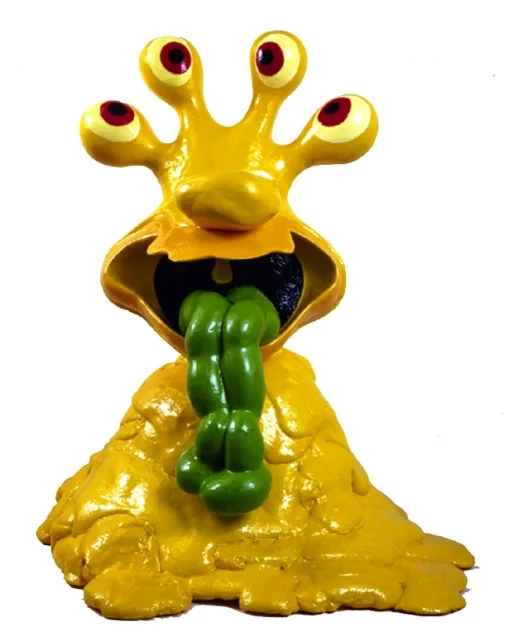
1986
© Kenny Scharf
Your work is playful and accessible, yet often critiques consumerism, technology and modern society. How do you balance joy and critique without compromising either?
I want to offer the viewer different levels of communication based on what the viewer chooses to see by combining the realities that are unpleasant yet everywhere with the joys and fun that are still around us. I am merely expressing the human condition where everything exists together at the same time and we each choose what to see and how to react.
Your blobs, doughnuts and surreal faces feel both timeless and very of-the-moment. How has your visual vocabulary evolved as culture and technology have changed?
Kenny Scharf: I think my subject matter and concerns that I address haven’t changed since my childhood. I feel basically I am a very traditional artist as I am mostly painting on canvas, not relying on technology only my mind and my hand. However, I welcome technological tools if they help me with this process.

Oil, Acrylic and spray paint on linen
with powder coated aluminum frame
60 x 48 Inches
© Kenny Scharf
Long before emojis, your work communicated emotion through simplified, exaggerated faces and symbols. Do you see your art as a kind of pre-digital emotional language? And how do you feel about today’s ‘emoji culture’ echoing your own visual language?
Kenny Scharf: Artists are often before their time. Artists are often harbingers of culture before it actually arrives. Growing up as the first generation with private light screens (color TV) I developed my visual language often through the screen. I was studying the cartoons and fell in love with the simplicity of emotions through cartoons. I became fascinated with how the features can be isolated and moved to create different expressions and emotions. I am attracted to the emotional side of painting so depicting emotions was a natural and as I said before, there was no plan to be ahead of my time, it just is.
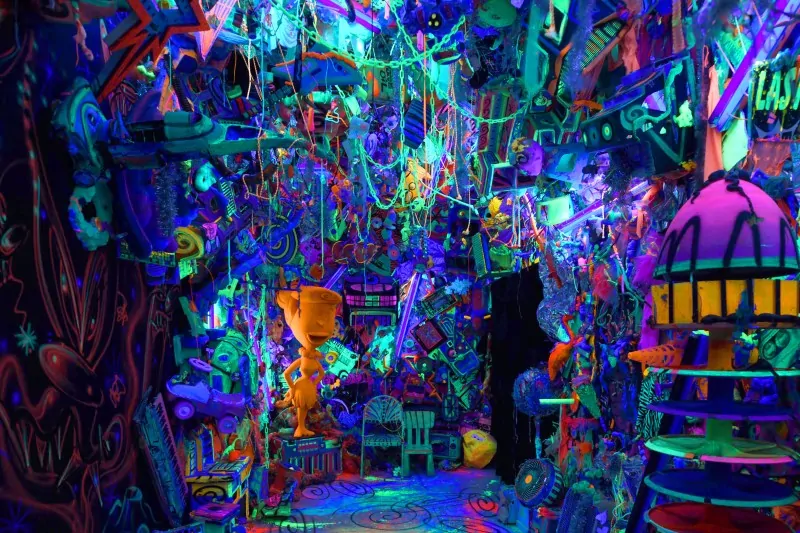
Beyond the Streets
Saatchi Gallery London 2023
© Kenny Scharf
The Cosmic Caverns remain one of your most iconic innovations — immersive, glowing environments that blur the lines between art, party and street. With the rise of experiences such as Meow Wolf and teamLab, do you feel vindicated or surprised that immersive art has become so mainstream?
Kenny Scharf: The Cosmic Cavern installations have been a constant for decades in my artistic practice. The idea of creating a space where you lose yourself from the realities of daily life using the detritus of daily life as material. I don’t feel the need for vindication and I’m definitely not surprised. Art has the ability to blur the lines of the high, low, popular and esoteric. If I had anything to do with this popularity, I can only hope it’s done well!
Your forthcoming MAM Shanghai show, Emotional, explores the full spectrum of feelings — anger, disgust, fear, happiness, sadness and awe — through your pop surrealist lens. What drew you to focus so directly on emotion at this point in your career?
Kenny Scharf: I’ve always focused on emotions throughout my career. The emotional is what attracts me. It is my way of expressing my own emotions. The art that I am drawn to is art that gives me emotional response as well. I want to feel!
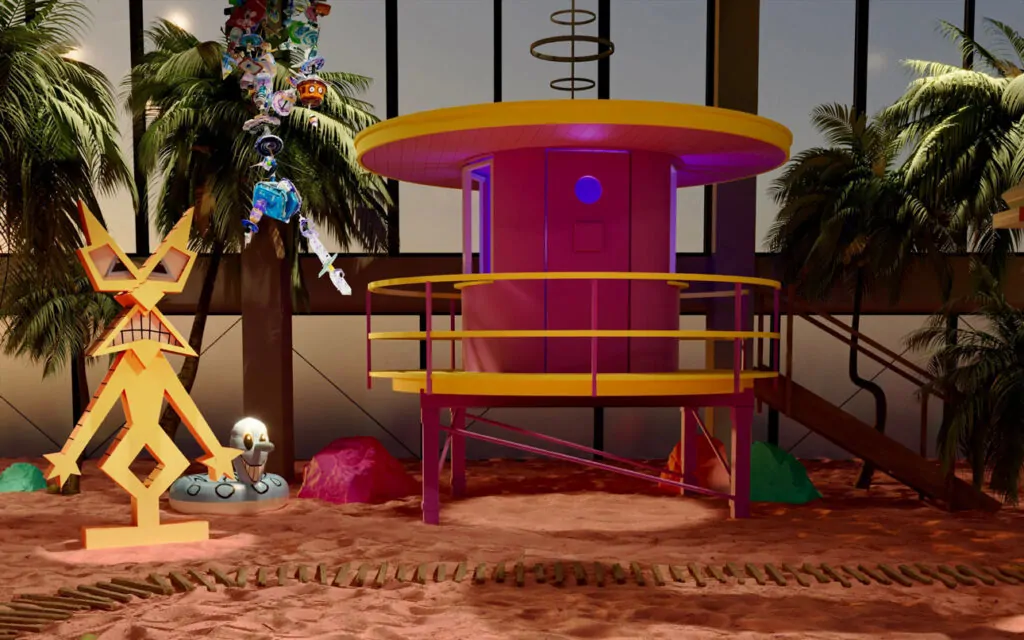
Beach Club Rendering
By Stefano Lattanzio
© Kenny Scharf
The Beach Club installation offers visitors full sensory immersion into your California beachside utopia. Why was it important to create this kind of physical, interactive space — particularly in a museum halfway across the world?
Kenny Scharf: The concept of the “Beach Club” was actually introduced by Shai Baitel, MAM Shanghai’s Artistic Director. He was responding to elements of my past and my recent installations, incorporating paint, sculpture, and living plants to offer the viewer a glimpse into a place that is welcoming more than just to look and to see, but to actually experience. The only thing we can’t include is the ocean itself. I love the concept of freedom of the spirit that the beach provides, and I’m hoping that the viewer can feel immersed in this experience.
After four decades, your work remains vibrant and relevant. How has the dialogue between ‘high’ and ‘low’ art shifted since the 1980s? Where does pop surrealism sit today?
Kenny Scharf: Thank you, the dialogue is constantly changing. The art world of the 80s compared to today was tiny. Now it has so many levels and categories and audiences. For me it’s important to know the history of art and unfortunately, I see a lot of things that seem to be unaware of this rich history. That is unfortunate, and difficult to create truly consequential work.
Pop surrealism is a term I coined back in the early 80s, basically to describe a lot of my art. I imagine myself as a surrealist drawing from my unconscious and subconscious mind, yet many of these images are from popular culture because of the intense saturation I encountered while I was developing my visual language. I can’t control whoever else wants to use this term and interpret it.

Kenny Scharf
16-34.25×48
© Kenny Scharf
Many young artists are inspired by your fearless blending of street art, cartoons and fine art. What advice would you give to emerging artists trying to navigate the art world whilst staying true to their vision?
Kenny Scharf: My advice is stay true to yourself and what feels authentic to you, although artists must navigate the politics and the machinations of the art world if they want to have a career, but I suggest divorcing your mind from any such thoughts, other than the art itself and your true inspiration.
After all these years of blending optimism, critique and escapism — what still excites you each time you enter your studio?
Kenny Scharf: I’ve created a stage for myself, which is so large and infinite that I can never be bored and I’m never at a loss for where to go next. I am constantly learning and discovering new things sometimes combining different elements of past work to create new work, but the risk of having faith is always exciting. By creating my own tension of not planning ahead, I am opening myself up to the unknown, which is always a thrill!
KENNY SCHARF: EMOTIONAL opens on the 28th of June, 2025 until the 8th of October, 2025 at The Modern Art Museum (MAM) Shanghai
©2025 Kenny Scharf


